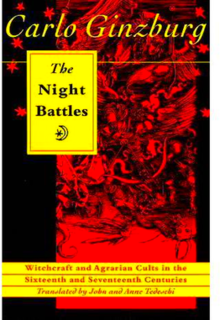 The first English-language edition of the book | |
| Author | Carlo Ginzburg |
|---|---|
| Language | Italian, English |
| Subject | Italian history History of religion |
| Publisher | Giulio Einaudi, Routledge and Kegan Paul |
Publication date | 1966 |
| Publication place | Italy |
Published in English | 1983 |
| Media type | Print (Hardback and paperback) |
| Pages | 209 |
The Night Battles: Witchcraft and Agrarian Cults in the Sixteenth and Seventeenth Centuries is a historical study of the benandanti folk custom of 16th and 17th century Friuli, Northeastern Italy. It was written by the Italian historian Carlo Ginzburg, then of the University of Bologna, and first published by the company Giulio Einaudi in 1966 under the Italian title of I Benandanti: Stregoneria e culti agrari tra Cinquecento e Seicento. It was later translated into English by John and Anne Tedeschi and published by Routledge and Kegan Paul in 1983 with a new foreword written by the historian Eric Hobsbawm.
In The Night Battles, Ginzburg examines the trial accounts of those benandanti who were interrogated and tried by the Roman Inquisition, using such accounts to elicit evidence for the beliefs and practices of the benandanti. These revolved around their nocturnal visionary journeys, during which they believed that their spirits traveled out of their bodies and into the countryside, where they would do battle with malevolent witches who threatened the local crops. Ginzburg goes on to examine how the Inquisition came to believe the benandanti to be witches themselves, and ultimately persecute them out of existence.
Considering the benandanti to be "a fertility cult", Ginzburg draws parallels with similar visionary traditions found throughout the Alps and also from the Baltic, such as that of the Livonian werewolf, and also to the widespread folklore surrounding the Wild Hunt. He furthermore argues that these Late Medieval and Early Modern accounts represent surviving remnants of a pan-European, pre-Christian shamanistic belief concerning the fertility of the crops.
Academic reviews of The Night Battles were mixed. Many reviewers argued that there was insufficient evidence to indicate that the benandanti represented a pre-Christian survival. Despite such criticism, Ginzburg would later return to the theories about a shamanistic substratum for his 1989 book Ecstasies: Deciphering the Witches' Sabbath, and it would also be adopted by historians like Éva Pócs, Gábor Klaniczay, Claude Lecouteux and Emma Wilby.